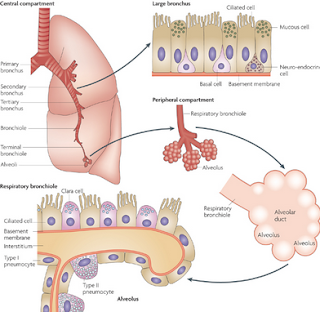 |
| Illustration of Types of Lung Cancer |
- Non Small Cell Lung Cancer (NSCLC), subdivided
Adenocarcinoma: This type develops from the cells that produce mucus (sputum) on the surface of the airways (airways). This type of cancer is more common. NSCLC is the most common type, approximately 30-40% of all cases of NSCLC. This type mainly occurs in women and those who do not smoke. Most cases of adenocarcinomas grown in the outer edges or lungs. This type has a tendency to spread to the lymph (lymph nodes) and distant areas of the lungs.
Bronchioloalveolar carcinoma is a sub-type of adenocarcinoma that frequently occur in several places in the lungs and spread to the walls of the alveoli (thin bubble that is the end of the line pernfasan and is the site of gas exchange). In the X-ray thorax (chest x-ray picture) the picture looks like pneumonia (inflammation of the lung, where the alveoli absorb oxygen which serves filled with fluid).
Large cell carcinoma: This cancer cells form under the microscope as the name implies: a large round cells. Often referred to as undifferentiated carcinoma. Sometimes referred to as undifferentiated carcinomas, are the least common type of NSCLC that happens, accounting for 10% -15% of all lung cancer cases. This species has a high tendency to spread to the lymph (lymph nodes) and distant areas of the lungs.
- Mixed tumor (mixed tumor)
- Small Cell Lung Cancer (SCLC)
More than 80% of lung cancer cases are NSCLC types. Mesothelioma is a type of cancer that attacks the mesothelium, the thin membrane lining the chest (pleura) and abdomen (peritoneum). Sometimes occurs in people who are exposed to asbestos. Several other types of cancer can grow in the lungs. This type is less common than with SCLC and NSCLC, the overall total is only 5-10% of all lung cancer cases.
Bronchial carcinoids
These tumors are generally small (3-4 cm) when diagnosed and occur most often under the age of 40 years, and was not related to smoking. Carcinoid to metastasize, and a small portion of these tumors secrete hormone-like substances. Carcinoid generally grow and spread more slowly than bronchogenic cancers (SCLC and NSCLC). Most of them are detected early enough so as to allow the operation disposed of.
Connective tissue cancers in the lung, such as smooth muscle or blood vessels, and cells involved in the body's immune response.
No comments:
Post a Comment